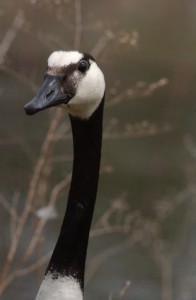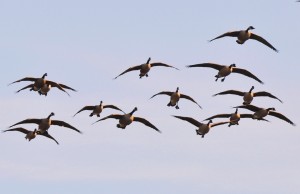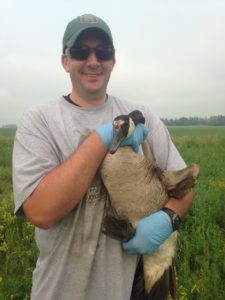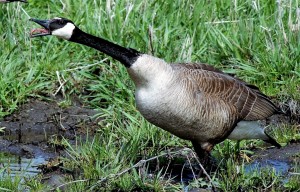Photography courtesy of Lowell Washburn, all rights reserved.
The morning wasn’t shaping up the way I had planned. With barely an hour to go until daybreak, the rain drops were rolling off my roof. Under the driveway yard light, the goose trailer was hooked to the truck and ready to go. But those decoys wouldn’t be heading anywhere today. The semi-remote corn field I planned to hunt would already be a muddy mess. There was no way to get a truck and trailer in without tearing things up.
When legal shooting time arrived, I was still at home drinking coffee, pacing the floor, looking out the windows. It was a sorry state of affairs. And then it struck me; that dim light at the end of the tunnel. I had suddenly remembered another field that I could reach on foot. My would-be goose hunt quickly switched to Plan B. Unhooking the trailer and trading more than 50 full bodied decoys for a bag of two dozen single dimensional silhouettes, I cranked up the truck and headed out. By the time I arrived at the field, the rain had backed off to a drizzle. Shouldering the decoys and shotgun, I headed for a prominent hillside halfway down the field. Reaching my destination, I quickly set the silhouettes on their stakes. Mission accomplished, I stepped back to evaluate the spread. Although that single bag of flat decoys didn’t look like much; it definitely beat staying indoors.
Settling in, it wasn’t long until I heard a couple bunches of geese in the distance although I never could see them through the gloom. Pretty soon, I heard another goose that sounded a lot closer. Attempting to strike up a conversation, I hit a few notes on my Eastern Shoreman call. I was soon pleased to determine that, with each answering honk, the sound of the real thing was becoming louder. Before long, the sound became a pair of honkers which suddenly burst through the haze. The geese were locked on; coming straight to the silhouettes. The closer the birds approached, the louder and more aggressive their honking became. Arriving at the decoys, the geese dropped their black legs and braked for a landing; presenting me with easy ten-yard chip shots. I always love it when a plan – especially a Plan B – comes together.
Rushing to retrieve my hefty goose dinners, I was excited — even more excited than I usually get when Canada geese almost land on my head. Here’s why. As the Canadas had closed the distance, I could clearly see that the front bird had a light, almost white colored breast and a noticeable white bar across its entire forehead – the historic and unmistakable, diagnostic markings of the legendary Giant Canada geese of yesteryear. Although I commonly observed birds with these unique characteristics during the early days of Iowa’s giant Canada goose recovery, the traits are seen far less frequently these days; although a handful will occasionally show up during statewide summer banding drives. It’s probably been more than 20 years since I’ve actually bagged one with markings as distinctive as the gander that sailed into the decoys this drizzly morning. Nice to know that at least a few of the old fashioned, True Giants are still in the gene pool.
The giant Canada goose is the largest of the 11 or so recognized races of Canada geese and is, in fact, the largest goose in the world. At the time of settlement, giant Canadas were an exceedingly common inhabitant of Iowa wetlands and homesteaders were quick to capitalize on this ready source of food, feathers, and eggs. Unable to cope with unregulated hunting pressure and widespread drainage of its breeding grounds, the species began a rapid decline. By 1907, the bird had completely vanished from the state. Meeting a similar fate elsewhere across its range, the bird was soon listed as an extinct species.
Early accounts of the giant goose were dramatic and intriguing. In addition to its enormous size, the bird was also famous for its light-colored breast and noticeably longer neck than other Canada geese. Pioneer hunters in Iowa, Minnesota, and the Dakotas also made frequent mention of the giant’s tendency to display a distinct “forehead bar”, a wide patch of snow white feathers often extending from “eyeball to eyeball”. Naturalists, sportsmen and birders lamented the species’ demise and universally mourned the fact that all that remained of this magnificent bird were a few mounted specimens and museum study skins.
Emerging from the Ashes: No wildlife species has ever returned from the abyss of extinction. But in the case of the giant Canada goose, the scientific world was turned on its head when in 1962, Harold Hanson rediscovered a small population of true giants wintering in Rochester, Minnesota. Reading of the event as a Junior High School student, I immediately began dreaming of someday traveling to Minnesota during winter and, if everything went just right, maybe having opportunity to catch a glimpse of the birds for myself.
As scientific interest surrounding the giant Canada continued to escalate, a small number of captive flocks were eventually discovered. The wild ancestry of at least one of those collections — discovered on a farm near Lotts Creek, Iowa — could be traced all the way back to when eggs and goslings were taken from the cattail wetlands of northern Iowa. Many of those captive giants were acquired by wildlife biologists with the Iowa Conservation Commission and the resoundingly successful goose restoration began. Today, the giant Canada goose has emerged from obscurity to become one of the world’s most abundant and recreationally important species of waterfowl. Totally funded by hunter dollars, the return of the giant Canada is one of the world’s most remarkably successful conservation victories. It’s an incredible achievement that all outdoor enthusiasts should be aware of.






 Tom Cope
Tom Cope Sue Wilkinson
Sue Wilkinson Susan Judkins Josten
Susan Judkins Josten Rudi Roeslein
Rudi Roeslein Elyssa McFarland
Elyssa McFarland Mark Langgin
Mark Langgin Adam Janke
Adam Janke Joe Henry
Joe Henry Kristin Ashenbrenner
Kristin Ashenbrenner Joe Wilkinson
Joe Wilkinson Dr. Tammy Mildenstein
Dr. Tammy Mildenstein Sean McMahon
Sean McMahon